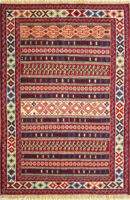Om Soumack
Soumak The Soumak carpets are in the same family as kelim. However, they are made according to a different weaving technique, of which there are several variations. Most soumak carpets from Iran are made near Ardebil, in the north-west, or nearby Sirdjan, in the south-east. Soumak carpets are very much...Read more
Showing the single result
Showing the single result
Mere om Soumack
Soumak
The Soumak carpets are in the same family as kelim. However, they are made according to a different weaving technique, of which there are several variations. Most soumak carpets from Iran are made near Ardebil, in the north-west, or nearby Sirdjan, in the south-east.
Soumak carpets are very much like kelim-carpets
There is just as much to say about kelim carpets as there is about pile carpets. My book would be twice as long if I had to write a comprehensive account of kelim carpets. However, it is important to know and recognise your limitations, and my knowledge of kelim carpets is nowhere near as extensive as my knowledge of Persian pile carpets. My family and I have been regularly encountering kelim carpets in connection with our procurement trips. We have also bought and sold some of them, but only in 2012 did we establish a department for kelim carpets in our business and thus started actively dealing with them. Therefore, we still have much to learn about this branch of the carpet industry. I just want to write a little about them here, and to recommend that you read more in books written by kelim specialists. However, kelim carpets have some things in common with pile carpets. Most of them are made in the same countries, at the same locations, in the same villages and by the same nomadic tribes. The patterns, traditions and techniques go far back in history, and it is just as important that good raw materials are used for a kelim carpet as for a pile carpet. Finally, just as with pile carpets, there are replicas that you need to watch out for. The kelim carpet is plainly woven and thus has no pile. The pattern is created by the weft threads, that are fully covered by the warp threads. This technique is related to the tapestry technique. The weft threads are introduced by colour in the desired part of the breadth of the weave. The open gaps or slits that are often found in kelim appear between the colour fields. They can be kept open, or they can be sewed shut.
In some variants of the kelim technique, the different coloured adjacent threads are woven together. This prevents gaps. The thread ends can be hidden in the weave, which looks identical on either side, but they can also hang as loose threads on the backside of the carpet. Kelim woven carpets and textiles are also known from ancient Egypt and from several other parts of the world, such as Peru and Poland. However, Oriental kelim is the most famous. For example, the Safavid kelim carpets from 1500-1700 Iran, with silk gold and silver threads, the Persian kelim from Sanandaj (Senneh) and the Caucasian and Anatolian (Turkish) kelim. Most of the Iranian kelim is being made nearby Senneh in the Char-Har-Mahal province and in the Fars province in the south. In particular the large nomadic kelim is often sewed together from one or two strips that were woven on narrow looms. They do not always fit perfectly together, but that is also part of their charm. Kelim carpets of good quality can tolerate a lot more wear and tear than most people realise. There are few such antique carpets on the market, and if they are in perfect condition or carefully restored, they can be very valuable. On the other hand, new carpets of lesser quality can sometimes be bought so cheap that you would think they made a mistake calculating the price. As with pile carpets, it can pay to spend a bit more and get a lot more quality.
Soumak and Nimbaft
In some cases, you see a combination of knotting and weaving in the same carpet. These are called Nim-baft carpets. ‘Nim’ means half and ‘baft’ means knotted. There are thus areas of the carpet’s surface that are plainly woven, made with kelim or the soumak technique, and knotted areas with a pile. They have a special relief effect and can sometimes be very decorative and artistic.
Source:
You are reading an extract from the book ‘Oriental Carpets, Knottet with Love’ by Martin Munkholm.
This extensive book about all that is carpets can be borrowed in Danish libraries or be bought following this link: https://belle-rugs.dk/en/expertise/bookfilmlecture/
The book is published by Muusmann Forlag.
For more info: http://muusmann-forlag.dk/
You can find our selection of Soumak carpets underneath.

